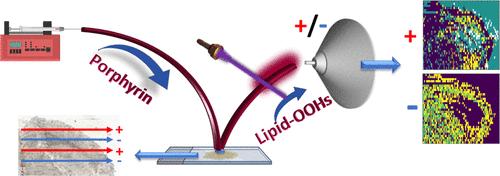用于高分子覆盖率异构体选择性脂质成像的通用光敏剂
IF 6.7
1区 化学
Q1 CHEMISTRY, ANALYTICAL
引用次数: 0
摘要
空间脂质组学是通过质谱成像(MSI)了解生物系统中脂质组复杂性的有力技术。最近的进展使异构体选择的MSI (iMSI)在生物样品中脂质使用在线和离线衍生化策略。尽管这些令人印象深刻的发展,大多数iMSI技术仅限于正离子或负离子模式分析,限制了在单个实验中可以实现的分子覆盖。此外,衍生化效率在不同的脂类中往往不同,这对全面的脂质分析提出了挑战。在这项研究中,我们介绍了四(4-羧基苯基)卟啉(TCPP)作为一种通用光敏剂,通过单线态氧(1O2)反应,在正负电离模式下促进在线脂质衍生化。该方法能够在基于液体萃取的环境电离技术中识别和定位酰基链组成和脂质碳-碳(C = C)异构体。我们还使用氟化钠(NaF)作为溶剂掺杂剂来增强对低丰度和低电离性生物分子的分析。通过将这些在线衍生化和信号增强策略与纳米喷雾解吸电喷雾电离(nano-DESI)相结合,我们在同一样品中实现了双极性iMSI。我们展示了低丰度异构体脂质的成像,否则将低于噪声水平。值得注意的是,TCPP显著提高了不饱和脂肪酸在线衍生化的效率,而其他光敏剂在这方面效率较低。这种新方法允许在同一实验中对来自多个类别的异构体脂肪酸和磷脂进行成像,揭示它们在生物组织中的独特空间定位。本文章由计算机程序翻译,如有差异,请以英文原文为准。

Universal Photosensitizer for Isomer-Selective Lipid Imaging with High Molecular Coverage
Spatial lipidomics is a powerful technique for understanding the complexity of the lipidome in biological systems through mass spectrometry imaging (MSI). Recent advancements have enabled isomer-selected MSI (iMSI) of lipids in biological samples using both online and off-line derivatization strategies. Despite these impressive developments, most iMSI techniques are limited to either positive or negative ion mode analysis, restricting the molecular coverage achievable in a single experiment. Additionally, derivatization efficiency often varies across lipid classes, presenting challenges for comprehensive lipid analysis. In this study, we introduce tetrakis(4-carboxyphenyl)porphyrin (TCPP) as a universal photosensitizer that facilitates online lipid derivatization in both positive and negative ionization modes via singlet oxygen (1O2) reaction. This method enables the identification and localization of both acyl chain compositions and lipid carbon–carbon (C═C) isomers in liquid extraction-based ambient ionization techniques. We have also employed sodium fluoride (NaF) as a solvent dopant to enhance the analysis of low-abundance and poorly ionizable biomolecules. By integrating these online derivatization and signal enhancement strategies with nanospray desorption electrospray ionization (nano-DESI), we achieved dual polarity iMSI within the same sample. We demonstrate imaging of low-abundance isomeric lipids, which were otherwise below the noise level. Notably, TCPP significantly enhances the efficiency of the online derivatization of unsaturated fatty acids, for which other photosensitizers are inefficient. This novel approach allows for the imaging of isomeric fatty acids and phospholipids from multiple classes in the same experiment, revealing their distinct spatial localization within biological tissues.
求助全文
通过发布文献求助,成功后即可免费获取论文全文。
去求助
来源期刊

Analytical Chemistry
化学-分析化学
CiteScore
12.10
自引率
12.20%
发文量
1949
审稿时长
1.4 months
期刊介绍:
Analytical Chemistry, a peer-reviewed research journal, focuses on disseminating new and original knowledge across all branches of analytical chemistry. Fundamental articles may explore general principles of chemical measurement science and need not directly address existing or potential analytical methodology. They can be entirely theoretical or report experimental results. Contributions may cover various phases of analytical operations, including sampling, bioanalysis, electrochemistry, mass spectrometry, microscale and nanoscale systems, environmental analysis, separations, spectroscopy, chemical reactions and selectivity, instrumentation, imaging, surface analysis, and data processing. Papers discussing known analytical methods should present a significant, original application of the method, a notable improvement, or results on an important analyte.
 求助内容:
求助内容: 应助结果提醒方式:
应助结果提醒方式:


